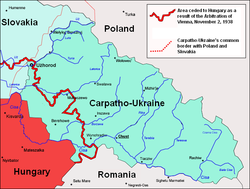Republic of Carpatho-Ukraine
| Carpatho-Ukraine | ||||||||||
| Карпатська Україна Karpatska Ukrayina |
||||||||||
| Unrecognized state | ||||||||||
|
||||||||||
|
|
||||||||||
|
Motto "Ще не вмерла Україна" (Ukrainian) "Shche ne vmerla Ukraina" "Ukraine has not yet died" |
||||||||||
|
Anthem Ще не вмерла Україна (Ukrainian) Shche ne vmerla Ukraina Ukraine has not yet died |
||||||||||
|
Map of Carpatho-Ukraine in 1939.
|
||||||||||
| Capital | Khust | |||||||||
| Languages | Ukrainian | |||||||||
| Government | Republic | |||||||||
| President | Avgustyn Voloshyn | |||||||||
| Prime Minister | Julian Révaý | |||||||||
| Legislature | Soim | |||||||||
| Historical era | Interwar period | |||||||||
| • | Independence | March 14, 1939 | ||||||||
| • | Conquered | March 15, 1939 | ||||||||
| Area | 13,352 km2 (5,155 sq mi) | |||||||||
|
||||||||||
| Today part of |
|
|||||||||
| Hungarian invasion of Carpatho-Ukraine | |||||||||
|---|---|---|---|---|---|---|---|---|---|
 Hungarian Border Guard Troops after execution of Sich members near Yasinia (March 1939) |
|||||||||
|
|||||||||
| Belligerents | |||||||||
|
|
|
||||||||
| Commanders and leaders | |||||||||
|
Avgustyn Voloshyn Zenon Kossak † |
Miklós Horthy András Littay |
||||||||
| Strength | |||||||||
| Carpathian Sich and OUN volunteers (2,000) | 40,000 | ||||||||
| Casualties and losses | |||||||||
|
Ukrainian military: killed, Ukrainian POW Ukrainian civilians: killed |
Hungarian military: killed, wounded Hungarian civilians: killed |
||||||||
Carpatho-Ukraine (Ukrainian: Карпа́тська Украї́на, Karpats’ka Ukrayina, pronounced [kɐrˈpɑtsʲkɐ ukrɐˈjinɐ]) was an autonomous region within Czechoslovakia from late 1938 to March 15, 1939. It was declared an independent republic by Avgustyn Voloshyn on March 15, 1939. Voloshyn named himself the president and asked Adolf Hitler to support him. Hitler did not reply and the historical part of Hungary was annexed by Hungary between March 15 and March 16, 1939, remaining under Hungarian control until the end of World War II, when it was ceded to the Soviet Union. The territory is now administered as Zakarpattia Oblast in Ukraine.
Soon after the implementation of the Munich Agreement of 29 September 1938 (by which Czechoslovakia lost much of its border region to Nazi Germany) Carpathian Ruthenia and Slovakia declared their autonomy within Czechoslovakia, which Prague accepted. The autonomous Carpathian Ruthenia (Subcarpathian Ruthenia 1919-38) changed its name to "Carpatho-Ukraine" soon afterwards, in November 1938.
In November 1938, under the First Vienna Award, which resulted from the Munich agreement, Nazi Germany and Italy prevailed on Czechoslovakia to cede the southern third of Slovakia and southern Carpatho-Ukraine to Hungary.
...
Wikipedia



